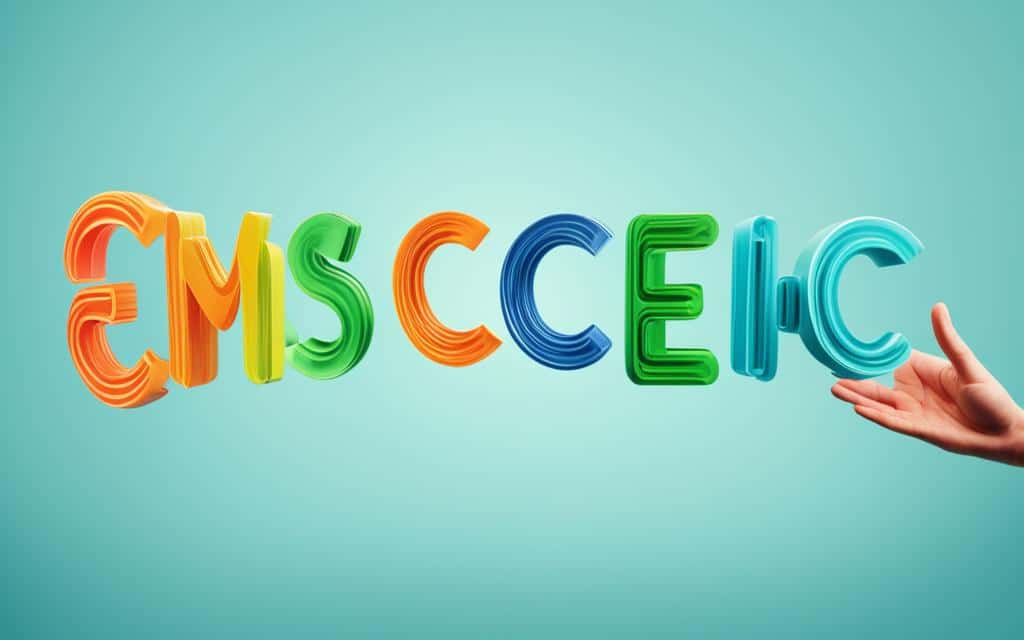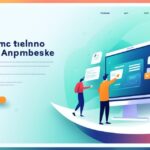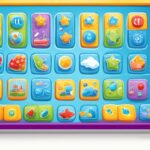Table of Contents
Interactive typography is an innovative approach to design that captivates audiences through the use of interactive elements incorporated into typography. It allows designers to create immersive and memorable experiences for users by leveraging motion, animation, and interactive tutorials.
Interactive typography enhances engagement, grabs attention, and leaves a lasting impression on the audience. It includes elements such as kinetic typography animations, interactive tutorials, and typography games, all of which contribute to a deeper level of user engagement.
By experimenting with text, designers can create visually stunning compositions that evoke emotions and communicate messages effectively. Through the integration of interactive elements, typography becomes a powerful tool for enhancing user engagement and creating dynamic visual experiences. Stay tuned to discover the power and possibilities of interactive typography in the upcoming sections!
The Power of Interactive Type Tutorials
Interactive type tutorials are a valuable resource for designers looking to enhance their typography skills and create visually captivating text. These tutorials provide a hands-on learning experience, offering practical examples and interactive elements that empower designers to explore new ways of styling text, discover great fonts, and utilize typographical design patterns.
By participating in interactive type tutorials, designers can:
- Learn about font pairing and typographic hierarchy
- Understand the impact of different typefaces on design compositions
- Sharpen their font design skills
- Explore the art of typography
Interactive tutorials go beyond theoretical explanations, allowing designers to put their knowledge into practice in a dynamic and engaging manner. Through interactive elements, such as drag-and-drop exercises and real-time previews, designers can experiment with different font styles and layouts, honing their typography skills and refining their design aesthetic.
Additionally, these tutorials provide invaluable insights into the world of type design. Designers can immerse themselves in the process of creating fonts, gaining a deeper understanding of letterforms, kerning, and typographic details. This knowledge equips designers with the expertise to produce unique and impactful typography that captures attention and delivers the intended message.
With the power of interactive type tutorials, designers have the opportunity to push the boundaries of their creativity and skillset, resulting in visually stunning and engaging typography that enhances any design project.
Discover the endless possibilities of interactive type tutorials and unlock your typography skills, creating remarkable designs that captivate audiences.
Styling Text with Interactive Elements
Interactive type tutorials provide designers with the opportunity to experiment with various techniques for styling text and incorporating interactive elements, resulting in an enhanced user experience. These tutorials offer step-by-step instructions and demonstrations, enabling designers to follow along and practice in real-time. By integrating interactive elements such as hover effects, scroll animations, and clickable text, designers can transform static typography into engaging and dynamic visual experiences that capture the user’s attention.
With interactive type tutorials, designers can explore different methods to style text effectively and create visually appealing compositions. By leveraging interactive elements, designers can add depth, interactivity, and visual interest to their typographic designs. For instance, hover effects can reveal hidden messages or additional information, providing an interactive and intriguing experience for users. Scroll animations can add movement and fluidity to the text, enhancing the storytelling aspect of the design. Clickable text can be utilized to navigate through content or trigger specific actions, encouraging user interaction and exploration.
Incorporating interactive elements into typography not only improves the aesthetics of the design but also enhances the functionality and user engagement of the interface. By implementing thoughtful interactive features, designers can create a captivating user experience that encourages users to stay on the page, explore the content, and interact with the text. This combination of styling text and interactive elements results in an engaging and immersive interface that keeps users hooked and encourages them to spend more time interacting with the content.
Benefits of Styling Text with Interactive Elements
- Enhanced visual appeal and aesthetic appeal
- Improved user engagement and interaction
- Increased time spent on the page
- Greater retention of information
- Enhanced storytelling and narrative through typography
Integrating interactive elements into typography adds a layer of interactivity and visual interest to the design, fostering a deeper connection between the user and the content. By engaging users through interactive elements such as hover effects, scrolling animations, and clickable text, designers can create a memorable and immersive experience that leaves a lasting impression.
Discovering Great Fonts for Impactful Designs
When it comes to creating impactful designs, choosing the right fonts plays a crucial role. Fonts have the power to evoke emotions, set the tone, and convey a brand’s personality. Designers often struggle with finding the perfect fonts that resonate with their audience and enhance their designs. That’s where interactive type tutorials come in.
Interactive type tutorials provide designers with a wealth of resources to discover new fonts and learn how to evaluate their suitability for different design purposes. Through these tutorials, designers can gain valuable insights into font pairing, legibility, and the impact of different typefaces on the overall design composition.
Font Pairing
Font pairing is the art of combining different fonts to create visually appealing and harmonious designs. The right font pairing can enhance the overall aesthetic of a design and create a strong visual hierarchy. Interactive type tutorials allow designers to explore various font combinations and understand the principles behind successful font pairing.
They provide designers with the opportunity to experiment with different font styles, such as pairing a bold and eye-catching headline font with a clean and legible body font. By understanding how different fonts interact with each other, designers can create visually striking compositions that capture attention and convey the intended message.
Impact of Different Typefaces
Every typeface has its own unique characteristics and conveys a specific mood or aesthetic. Interactive type tutorials enable designers to explore various typefaces and understand their impact on design compositions. They can experiment with serif fonts for a classic and elegant look, sans-serif fonts for a modern and minimalistic vibe, or display fonts for a bold and expressive statement.
By understanding how different typefaces influence the overall design, designers can make informed decisions that align with the project’s goals and target audience. They can choose fonts that not only look visually appealing but also effectively communicate the brand’s message and personality.
Exploring Font Showcase and Comparison Demos
Interactive type tutorials often include font showcase and comparison demos, which allow designers to explore a wide range of fonts and compare their visual impact. These demos provide designers with a curated selection of fonts to browse through, showcasing the versatility and uniqueness of each typeface.
Designers can examine the characteristics of each font, such as legibility, readability, and stylistic features, in order to select the perfect font for their design. These font showcase and comparison demos streamline the font discovery process, saving designers valuable time and ensuring that they find great fonts for their impactful designs.
Enhancing user engagement with Kinetic Typography and Typography Games
Kinetic typography is a captivating form of expression that utilizes animation to engage viewers and tell stories through type. With kinetic typography, designers can create eye-catching animations that instantly grab attention and guide the viewer’s eye across the screen. By combining motion and typography, designers evoke emotions and create memorable experiences that leave a lasting impression.
Typography games, on the other hand, offer a fun and interactive way for designers to enhance their typography skills. Through interactive challenges and exercises, designers can sharpen their ability to identify different typefaces, improve kerning and rag-setting skills, and explore various font design techniques. These engaging activities not only serve as a source of entertainment but also provide valuable learning experiences, helping designers expand their creative horizons and refine their craft.
By incorporating kinetic typography animations and typography games, designers can significantly enhance user engagement. The dynamic nature of kinetic typography animations grabs attention and keeps viewers captivated, while typography games provide an interactive platform for users to actively participate and learn. These elements not only make the user experience more enjoyable but also foster a deeper connection between the audience and the design, resulting in increased user engagement and a memorable visual impact.
FAQ
What is interactive typography?
Interactive typography is an innovative approach to design that incorporates interactive elements into typography to create immersive and engaging experiences for users.
How can interactive typography enhance engagement?
By leveraging motion, animation, and interactive tutorials, interactive typography grabs attention, captivates audiences, and leaves a lasting impression on the audience.
What are interactive type tutorials?
Interactive type tutorials are valuable resources that provide hands-on learning experiences for designers to enhance their typography skills and discover new ways of styling text.
How do interactive type tutorials help designers?
Interactive type tutorials empower designers to explore font pairing, typographic hierarchy, and the impact of different typefaces on design compositions, ultimately sharpening their font design skills and exploring the art of typography.
How can designers incorporate interactive elements into styling text?
Designers can transform static typography into engaging and dynamic visual experiences by adding interactive elements like hover effects, scroll animations, and clickable text.
What insights can designers gain from interactive type tutorials?
Interactive type tutorials enable designers to discover new fonts, evaluate their suitability for different design purposes, and gain valuable insights into font pairing, legibility, and the impact of different typefaces on design compositions.
What is kinetic typography?
Kinetic typography is a captivating form of expression that utilizes animation to engage viewers and tell stories through type.
How can typography games enhance designers’ skills?
Typography games offer a fun and interactive way for designers to enhance their typography skills, improve their typeface identification, kerning, and rag-setting skills, and explore font design techniques.
How do interactive elements enhance user engagement?
By incorporating interactive elements into typography, designers can create captivating user interfaces that encourage user engagement and interaction.













